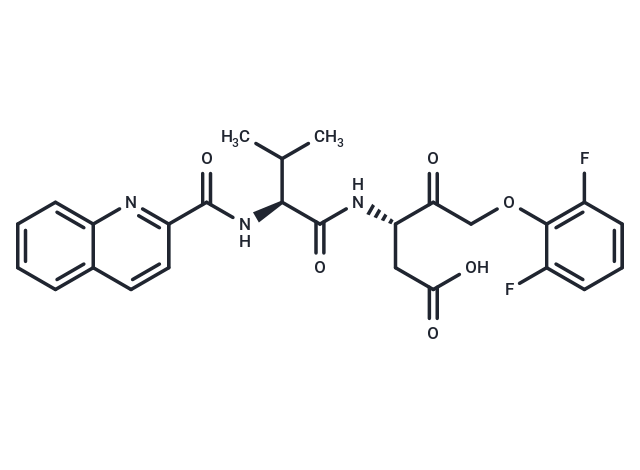Shopping Cart
Remove All Your shopping cart is currently empty
Your shopping cart is currently empty
Q-VD-OPh is an irreversible caspase inhibitor with an IC50 value of 48 nM against caspase-7 and between 25 and 400 nM against caspase-1, 3, 8, 9, 10, 12. Q-VD-OPh inhibits HIV infection and can cross the blood-brain barrier.

| Pack Size | Price | USA Warehouse | Global Warehouse | Quantity |
|---|---|---|---|---|
| 1 mg | $47 | - | In Stock | |
| 5 mg | $87 | - | In Stock | |
| 10 mg | $147 | - | In Stock | |
| 25 mg | $237 | - | In Stock | |
| 50 mg | $368 | - | In Stock | |
| 100 mg | $547 | - | In Stock | |
| 1 mL x 10 mM (in DMSO) | $98 | - | In Stock |
| Description | Q-VD-OPh is an irreversible caspase inhibitor with an IC50 value of 48 nM against caspase-7 and between 25 and 400 nM against caspase-1, 3, 8, 9, 10, 12. Q-VD-OPh inhibits HIV infection and can cross the blood-brain barrier. |
| Targets&IC50 | Caspase-9:25 nM-400 nM, Caspase-12:25-400 nM, Caspase-3:25 nM-400 nM, Caspase-10:25-400 nM, Caspase-1:25 nM-400 nM, Caspase-8:25 nM-400 nM, Caspase-7:48 nM |
| In vitro | METHODS: The apoptosis of cardiomyocytes treated with Q-VD-OPH was detected by Flow Cytometry RESULTS: Q-VD-OPH could protect cardiomyocytes from virus-induced apoptosis. [1] |
| In vivo | METHODS: To study the effects of Q-VD-OPH on apoptosis, immune response, and virus replication, SIVmac251 virus was administered intravenously to Chinese macaques to mimic HIV infection, and Q-VD-OPH (20 mg/kg) was administered intravenously to Chinese macaques on days 5, 7, 9, 11, and 14. RESULTS: Q-VD-OPH significantly reduced the level of apoptosis of T cells in peripheral lymph nodes. The number of TUNEL+ cells was significantly lower in the Q-VD-OPh treated group than in the untreated group. Q-VD-OPH treatment significantly increased CD4+ T cell count and CD4/CD8 ratio and decreased viral replication. [2] METHODS: To study the protective effect of Q-VD-OPH on ischemic acute renal failure (ARF), Q-VD-OPH (120 mg/kg) was intraperitoneally injected into mice. RESULTS: Q-VD-OPH inhibited the expression of caspase-1 and IL-18 and neutrophil infiltration in ischemic ARF mice. [3] METHODS: To study the protective effect of Q-VD-OPH on myocardial injury, Q-VD-OPH (50 mg/kg) was intraperitoneally injected into virus-infected mice on days 3 to 6. RESULTS: Q-VD-OPH protected against virus-induced myocardial injury by inhibiting caspase activity. [1] METHODS: To study the therapeutic effect of Q-VD-OPH on AD, TgCRND8 mice were intraperitoneally injected with Q-VD-OPH (10 mg/kg) three times a week for three months. RESULTS: Q-VD-OPH inhibited caspase-7 activation and the pathological changes associated with tau protein, including caspase cleavage. [4] |
| Kinase Assay | Enzyme assay is conducted in buffer containing 25 mM Tris, pH 8.0, 1 mM DTT, 1 mM spermine, 50 mM KCl, 0.01% Nonidet P-40, and 1 mM MgCl2. PARP reaction contains 0.1 μCi [3H]NAD+ (200?000 DPM), 1.5 μM NAD+, 150 nM biotinylated NAD+, 1 μg/mL activated calf thymus, and 1?5 nM PARP-1. Autoreactions utilizing SPA bead-based detection are carried out in 50 μL volumes in white 96-well plates. Compounds (e.g., MK-4827) are prepared in 11-point serial dilution in 96-well plate, 5 μL/well in 5% DMSO/Water (10× concentrated). Reactions are initiated by adding first 35 μL of PARP-1 enzyme in buffer and incubating for 5 min at room temperature and then 10 μL of NAD+ and DNA substrate mixture. After 3 h at room temperature, these reactions are terminated by the addition of 50 μL of streptavidin-SPA beads (2.5 mg/mL in 200 mM EDTA, pH 8). After 5 min, they are counted using a TopCount microplate scintillation counter. IC50 data is determined from inhibition curves at various substrate concentrations[1]. |
| Cell Research | Caspase inhibitors are added at the indicated concentrations 30 minutes prior to the addition of apoptotic stimuli. Viability and cell number are determined by trypan blue exclusion from three random fields of greater than 200 cells/field. All experiments are performed a minimum of three times.(Only for Reference) |
| Synonyms | Quinoline-Val-Asp-Difluorophenoxymethylketone |
| Molecular Weight | 513.5 |
| Formula | C26H25F2N3O6 |
| Cas No. | 1135695-98-5 |
| Smiles | CC(C)[C@H](NC(=O)c1ccc2ccccc2n1)C(=O)N[C@@H](CC(O)=O)C(=O)COc1c(F)cccc1F |
| Relative Density. | 1.346 g/cm3 at 20℃ |
| Storage | keep away from moisture,store at low temperature | Powder: -20°C for 3 years | In solvent: -80°C for 1 year | Shipping with blue ice/Shipping at ambient temperature. | |||||||||||||||||||||||||||||||||||
| Solubility Information | Ethanol: 100 mg/mL (194.74 mM), Sonication is recommended. DMSO: 260 mg/mL (506.33 mM), Sonication is recommended. | |||||||||||||||||||||||||||||||||||
| In Vivo Formulation | 10% DMSO+40% PEG300+5% Tween 80+45% Saline: 5 mg/mL (9.74 mM), Sonication is recommended. Please add the solvents sequentially, clarifying the solution as much as possible before adding the next one. Dissolve by heating and/or sonication if necessary. Working solution is recommended to be prepared and used immediately. The formulation provided above is for reference purposes only. In vivo formulations may vary and should be modified based on specific experimental conditions. | |||||||||||||||||||||||||||||||||||
Solution Preparation Table | ||||||||||||||||||||||||||||||||||||
Ethanol/DMSO
| ||||||||||||||||||||||||||||||||||||
| Size | Quantity | Unit Price | Amount | Operation |
|---|

Copyright © 2015-2025 TargetMol Chemicals Inc. All Rights Reserved.